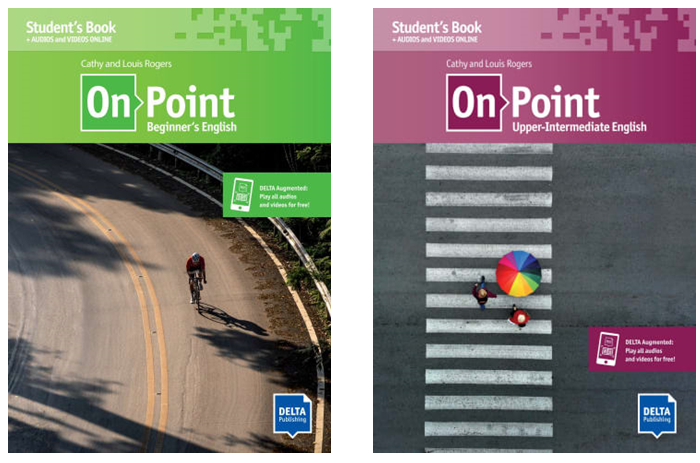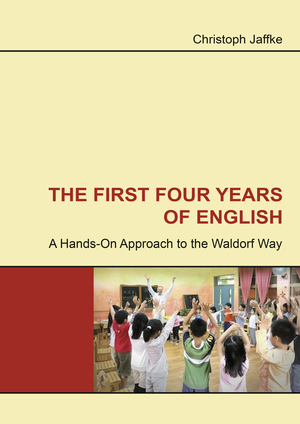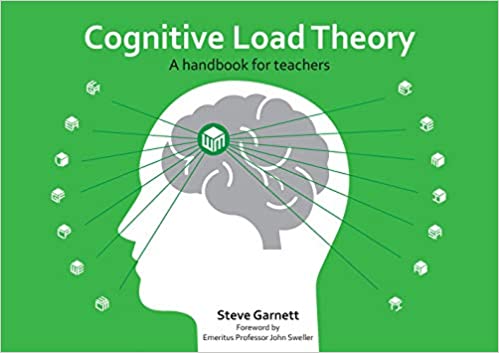Short Book Reviews
Hanna Kryszewska is a teacher, teacher trainer, trainer of trainers. She is a senior lecturer at the University of Gdańsk, Poland. She is co-author of resource books: Learner Based Teaching, OUP, Towards Teaching, Heinemann, The Standby Book, CUP, Language Activities for Teenagers, CUP, The Company Words Keep, DELTA Publishing, and a course book series for secondary schools: ForMat, Macmillan. She is also co-author of a video based teacher training course: Observing English Lessons. Hania is a Pilgrims trainer and editor of HLT Magazine. E-mail: hania.kryszewska@pilgrimsteachertrainig.eu

On Point. Beginner’s English. C. and L. Rogers. (2021) DELTA Publishing. ISBN-978-3-12-501265-3, pp 128. On Point. Upper-Intermediate English. C. and L. Rogers. (2021) DELTA Publishing. ISBN-978-3-12-501275-2, pp 160. The two titles are part of a new series of course books for adults which takes learners from A1 level to C1 level. According to the blurb the course “takes the best traditional teaching methods to give students a classic approach to learning English’. And indeed there are no pedagogical surprises, which many teachers and more mature learners will welcome. The two books under review follow roughly the same template but there are some differences. In Beginner’s English each of the twelve chapters is divided into three parts. Part A and B focus on grammar with elements vocabulary work, reading, listening and speaking to provide context for the individual grammar points; part C focuses on productive skills – speaking and writing. In Upper-Intermediate English each of the ten chapters is divided into four parts. Part A and B focus on grammar with elements of reading, listening and speaking to provide context for the individual grammar points, part C focuses on reading and recycling of the grammar points from parts A and B, and, finally, section D focuses on productive skills – speaking and writing. Both the books contain Video Pages with video lessons related to the themes of the units. The course is easy to follow both for the teacher and learners, and the topics are modern and fresh. If the approach in the books is traditional, the various options and extras of the course are very modern; there are options for online courses, there is a digital edition with interactive exercises in the Learning Management System (LMS) BlinkLearning, and a free DELTA Augmented app with audios, videos and access to audible flashcards.

The First Four Years of English. A Hands-On Approach to the Waldorf Way. C. Jaffke (2021) Pädagogische Forschungsstelle Stuttgart. ISBN- 978-3-949267-14-7, pp 164. Waldorff schools are based on Rudolph Steiner’s educational philosophy in which teaching foreign languages plays a very important role. Children learn two foreign languages three times a week for 12 years. The process of language learning, like many other aspects of Waldorff education, is related to or depends on music and “imitative musical abilities”. The language learning cycle involves movement, imitation and then language. The book looks at teaching English in the Lower School which comprises grades from one to four. The book first characterises language teaching at this stage, cognitive processes children experience, the role of the parents and, of course, draws a profile of the type of teacher that is needed for this teaching approach. The author presents the development stages of children from grade one to grade four. The section on practical aspects of foreign language teaching includes the Direct Method, Total Physical Response, storytelling, grammar and vocabulary work. This would be the theoretical underpinning but more than half of the book is taken by practical activities. In Repertoire Selection: Groups of Material you will find a wealth of ideas and materials based among others on actions rhymes, finger plays, rhymes, elements of CLIL and everyday poetry. In Stories to Tell and Act you will find texts of 15 stories and ideas how to tell stories using facial expressions, gestures, postures, using voice, intonation, right staging of the stories, and eye contact. The author has 50 year experience of teaching English in a Waldorf school which he generously shares with the readers of this book. I am sure mainstream primary English teachers will find inspiration on the pages of this publication.

Textploitation. Mining texts for all they are worth. D. Byrne and M. Heffernan. (2020)DELTA Publishing. ISBN- 9783125015791 pp 144. The photo you can see on the cover of the book is very important. It shows workmen diggers uncovering a huge gem. This a metaphor summarising what this resource book does; it teaches how to uncover the gems that are hidden in a text and how to exploit the text’s full potential. This metaphor is continued on the first page called: Digging deeper to find the gems where four differently shaped and cut gems introduce four topics: 1. What’s so special about the book?, 2. How does it work?, 3. How’s it going to help you?, and 4. What will I get from this book?. So I will try to answer these four questions. 1. The focus is not just on the texts, their lexis, grammar and content but also on ways to: develop learner autonomy, analyse texts, ask questions including ways to exercise critical thinking, bring together the classroom and the outside world, and practice micro-skills (reflecting, questioning, summarizing, and paraphrasing). 2. The book is divided into four sections focusing on four types of texts: articles, stories, conversations and tiny texts. Each section has texts and sample procedures suitable for various levels. The various aspects of an activity and going about the text are signalled by icons, and the procedures are very easy to follow. 3. This resource book is not just a collection of recipes but it also aims to train teachers as they conduct the activities. Hopefully, after using this book, teachers will start to develop their own materials and activities. 4. There are plenty of ideas to be used instantly in class, points to consider when working with texts, innovative ways of working with texts, templates to follow when developing own materials and a lot more. Very inspiring.

Cognitive Load Theory. A handbook for teachers. S. Garnett. (2020) Crown House Publishing Limited. ISBN-978-178583501-8, pp 123. In a nutshell Cognitive Load Theory (CLT) is to do with the amount of working memory needed to learn something, or the resources available in working memory so that we can learn. Cognitive load involves three areas: the cognitive to do with the effort to learn, the extraneous to do with the way the learner is presented with information or through what tasks, and the germane to do with the work needed so that the new information is put into “a permanent store of knowledge”. Cognitive Load Theory formulated by John Sweller has been around since late 1980ies but in ELT we rarely if ever hear or use the term. For example, in Memory Activities for Language Learning (Cambridge 2011) Nick Bilbrough talks about memory and the way we need to help language learners remember lexis, but he never uses the term CLT, the names of the three CLT areas nor refers to them without naming them the way Sweller labelled them. John Sweller’s book which is the subject of this review is not aimed at ELT teachers but at teachers in general, yet I believe language teachers would greatly benefit from the book. The book ”brings clarity to the complexity surrounding cognitive load theory (CLT) and provides a user-friendly toolkit of techniques designed to help teachers optimise their pupils”. The introduction presents the main ideas of the theory followed by four sections relating to how to introduce a new topic, how to teach new skills or facts, how to check recall and understanding, and, finally, how learners can demonstrate understanding. These four sections are full of practical ideas, examples and diagrams which make the information very accessible and easy to absorb. The book is very inspiring and I am sure an ELT teacher will find a lot of inspiration.
Please check the Pilgrims f2f courses at Pilgrims website.
Please check the Pilgrims online courses at Pilgrims website.
Short Book Reviews
Hanna Kryszewska, PolandNew books from Pavilion: Live Online Teaching by Jill Hadfield and Lindsay Clandfield and Learning While Teaching by Daria Vaskova